Sustainable Energy and Semiconductors: A Bibliometric Investigation
Abstract
1. Introduction
- (1)
- What are the key factors driving the shift in research focus from semiconductors’ basic properties and applications to the environmental impacts and sustainability of semiconductor manufacturing and disposal?
- (2)
- How have interdisciplinary collaborations between North American, European, and East Asian institutions influenced advancements in sustainable semiconductor technologies?
- (3)
- Which seminal works and influential publications have had the most significant impact on developing sustainable manufacturing processes and integrating semiconductors with renewable energy technologies, and what are their main contributions?
2. Literature Review
2.1. Overview of Existing Research on the Sustainability Aspects of Semiconductor Technologies
2.2. Identification of Key Themes and Research Trends in This Domain
2.3. Gaps and Limitations in the Current Understanding of the Topic
3. Methodology
3.1. Data Collection
3.2. Bibliometric Methodology
4. Results and Discussion
4.1. Temporal Evolution of Publications
4.2. Sustainable Development Goals’ Implications
4.3. Interdisciplinary Collaborations in Semiconductor Research
4.4. Research Trends and Potential Future Research Directions
4.4.1. 2010–2012: Foundations in Semiconductor Materials
4.4.2. 2012–2014: Shift to Energy Conversion and Environmental Applications
4.4.3. 2014–2016: Focus on Manufacturing Processes and Industry
4.4.4. 2016–2018: Exploration of Sensing and Monitoring Technologies
4.4.5. 2018–2023: Diverse Semiconductor Research and Applications
5. Conclusions
5.1. Key Findings and Significance
5.2. Limitations and Future Research Opportunities
Author Contributions
Funding
Institutional Review Board Statement
Informed Consent Statement
Data Availability Statement
Conflicts of Interest
References
- Jaeger, R.C.; Blalock, T.N. Microelectronic Circuit Design; McGraw-Hill Education: New York, NY, USA, 2016. [Google Scholar]
- Shen, C.W.; Tran, P.P.; Minh Ly, P.T. Chemical waste management in the US semiconductor industry. Sustainability 2018, 10, 1545. [Google Scholar] [CrossRef]
- Bhattacharya, P.; Fornari, R.; Kamimura, H. Comprehensive Semiconductor Science and Technology; Elsevier: Amsterdam, The Netherlands, 2011. [Google Scholar]
- Streetman, B.G.; Banerjee, S. Solid State Electronic Devices; Prentice Hall: Saddle River, NJ, USA, 2015. [Google Scholar]
- Cenci, M.P.; Scarazzato, T.; Munchen, D.D.; Dartora, P.C.; Veit, H.M.; Bernardes, A.M.; Dias, P.R. Eco-friendly electronics—A comprehensive review. Adv. Mater. Technol. 2022, 7, 2001263. [Google Scholar] [CrossRef]
- Kemeç, A.; Altınay, A.T. Sustainable energy research trend: A bibliometric analysis using VOSviewer, RStudio bibliometrix, and CiteSpace software tools. Sustainability 2023, 15, 3618. [Google Scholar] [CrossRef]
- Neamen, D.A. Semiconductor Physics and Devices: Basic Principles; McGraw-Hill: New York, NY, USA, 2012. [Google Scholar]
- Maroti, P.K.; Padmanaban, S.; Bhaskar, M.S.; Ramachandaramurthy, V.K.; Blaabjerg, F. The state-of-the-art power electronics converters configurations in electric vehicle technologies. Power Electron. Devices Compon. 2022, 1, 100001. [Google Scholar] [CrossRef]
- Chou, C.H.; Ngo, S.L.; Tran, P.P. Renewable energy integration for sustainable economic growth: Insights and challenges via bibliometric analysis. Sustainability 2023, 15, 15030. [Google Scholar] [CrossRef]
- Arrigo, D.; Adragna, C.; Marano, V.; Pozzi, R.; Pulicelli, F.; Pulvirenti, F. The next “automation age”: How semiconductor technologies are changing industrial systems and applications. In Proceedings of the ESSCIRC 2022-IEEE 48th European Solid State Circuits Conference (ESSCIRC), Milan, Italy, 19–22 September 2022; pp. 17–24. [Google Scholar]
- Le, M.H.; Lu, W.M.; Chang, J.C. Recycling E-Waste and the Sustainable Economy: A Bibliometric Exploration. Sustainability 2023, 15, 16108. [Google Scholar] [CrossRef]
- Adjei Mensah, C.; Kweku Eshun, J.; Asamoah, Y.; Ofori, E. Changing land use/cover of Ghana’s oil city (Sekondi-Takoradi Metropolis): Implications for sustainable urban development. Int. J. Urban Sustain. Dev. 2019, 11, 223–233. [Google Scholar] [CrossRef]
- IPCC. Climate Change 2021: The Physical Science Basis. Contribution of Working Group I to the Sixth Assessment Report of the Intergovernmental Panel on Climate Change; Cambridge University Press: Cambridge, UK, 2021. [Google Scholar]
- Steffen, W.; Richardson, K.; Rockström, J.; Cornell, S.E.; Fetzer, I.; Bennett, E.M.; Biggs, R.; Carpenter, S.R.; De Vries, W.; De Wit, C.A.; et al. Planetary boundaries: Guiding human development on a changing planet. Science 2015, 347, 1259855. [Google Scholar] [CrossRef]
- United Nations. Transforming Our World: The 2030 Agenda for Sustainable Development. Resolution Adopted by the General Assembly. 2015. Available online: https://sustainabledevelopment.un.org/post2015/transformingourworld/publication (accessed on 25 June 2024).
- Le Blanc, D. Towards integration at last? The sustainable development goals as a network of targets. Sustain. Dev. 2015, 23, 176–187. [Google Scholar] [CrossRef]
- Tang, Z.; Yang, Y.; Blaabjerg, F. Power electronics: The enabling technology for renewable energy integration. CSEE J. Power Energy Syst. 2021, 8, 39–52. [Google Scholar]
- Mullen, E.; Morris, M.A. Green nanofabrication opportunities in the semiconductor industry: A life cycle perspective. Nanomaterials 2021, 11, 1085. [Google Scholar] [CrossRef]
- Chen, T. Strengthening the competitiveness and sustainability of a semiconductor manufacturer with cloud manufacturing. Sustainability 2014, 6, 251–266. [Google Scholar] [CrossRef]
- Amaral, R.E.; Brito, J.; Buckman, M.; Drake, E.; Ilatova, E.; Rice, P.; Sabbagh, C.; Voronkin, S.; Abraham, Y.S. Waste management and operational energy for sustainable buildings: A review. Sustainability 2020, 12, 5337. [Google Scholar] [CrossRef]
- Wessner, C.W.; Jorgenson, D.W. (Eds.) Enhancing Productivity Growth in the Information Age: Measuring and Sustaining the New Economy; National Academies Press: Washington, DC, USA, 2007. [Google Scholar]
- Sagar, S. Innovation and Sustainability in Business: Navigating the Future Landscape. IOSR J. Bus. Manag. 2023, 25, 51–60. [Google Scholar]
- Shen, C.W.; Tran, P.P.T.; Kuritsyn, M. The Relationship between Environmental Performance and Financial Performance: Panel Data Evidence from the US Semiconductor Industry. In Proceedings of the ICFE 2017—The 4th International Conference on Finance and Economics, Ho Chi Minh City, Vietnam, 21–22 September 2017. [Google Scholar]
- Gan, C.L.; Chung, M.H.; Zou, Y.S.; Huang, C.Y.; Takiar, H. Technological Sustainable Materials and Enabling in Semiconductor Memory Industry: A Review. E-Prime Adv. Electr. Eng. Electron. Energy 2023, 5, 100245. [Google Scholar] [CrossRef]
- Afonso, J.L.; Cardoso, L.A.L.; Pedrosa, D.; Sousa, T.J.; Machado, L.; Tanta, M.; Monteiro, V. A review on power electronics technologies for electric mobility. Energies 2020, 13, 6343. [Google Scholar] [CrossRef]
- Wang, J.B.; Wang, G.H.; Ou, C.Y. The Key Factors for Sustainability Reporting Adoption in the Semiconductor Industry Using the Hybrid FRST-PSO Technique and Fuzzy DEMATEL Approach. Sustainability 2023, 15, 1929. [Google Scholar] [CrossRef]
- Jayachandran, M.; Gatla, R.K.; Rao, K.P.; Rao, G.S.; Mohammed, S.; Milyani, A.H.; Azhari, A.A.; Kalaiarasy, C.; Geetha, S. Challenges in achieving sustainable development goal 7: Affordable and clean energy in light of nascent technologies. Sustain. Energy Technol. Assess. 2022, 53, 102692. [Google Scholar] [CrossRef]
- Javaid, M.; Haleem, A.; Singh, R.P.; Suman, R.; Gonzalez, E.S. Understanding the adoption of Industry 4.0 technologies in improving environmental sustainability. Sustain. Oper. Comput. 2022, 3, 203–217. [Google Scholar] [CrossRef]
- Chang, K.H.; Tsai, C.C.; Wang, C.H.; Chen, C.J.; Lin, C.M. Optimizing the energy efficiency of chiller systems in the semiconductor industry through big data analytics and an empirical study. J. Manuf. Syst. 2021, 60, 652–661. [Google Scholar] [CrossRef]
- Ramakrishna, S.; Ramasubramanian, B. Circular Practices in E-waste Management and Transportation. In Handbook of Materials Circular Economy; Springer Nature Singapore: Singapore, 2024; pp. 131–165. [Google Scholar]
- Pham, T.N.; Tran, P.P.; Le, M.H.; Vo, H.N.; Pham, C.D.; Nguyen, H.D. The effects of ESG combined score on business performance of enterprises in the transportation industry. Sustainability 2022, 14, 8354. [Google Scholar] [CrossRef]
- Allan, J.; Belz, S.; Hoeveler, A.; Hugas, M.; Okuda, H.; Patri, A.; Rauscher, H.; Silva, P.; Slikker, W.; Sokull-Kluettgen, B.; et al. Regulatory landscape of nanotechnology and nanoplastics from a global perspective. Regul. Toxicol. Pharmacol. 2021, 122, 104885. [Google Scholar] [CrossRef]
- Pan, Y.; Song, Y.; Zhang, C.C.; Zhu, Q.; Wu, J. Semiconductor Industry’s Transformation Path Under Circular Economy: Evidence from Micro-level Efficiency Evaluation. Comput. Ind. Eng. 2024, 189, 109934. [Google Scholar] [CrossRef]
- Athwer, A.; Darwish, A. A Review on Modular Converter Topologies Based on WBG Semiconductor Devices in Wind Energy Conversion Systems. Energies 2023, 16, 5324. [Google Scholar] [CrossRef]
- Singh, R.; Singh, K.K. Role of Semiconductors in Solar Energy. J. Inform. Electr. Electron. Eng. 2022, 3, 1–6. [Google Scholar] [CrossRef]
- Wang, R.; Liu, H.; Zhang, Y.; Sun, K.; Bao, W. Integrated photovoltaic charging and energy storage systems: Mechanism, optimization, and future. Small 2022, 18, 2203014. [Google Scholar] [CrossRef]
- Islam, M.S.; Ahsan, M.S.; Rahman, M.K.; AminTanvir, F. Advancements in Battery Technology for Electric Vehicles: A Comprehensive Analysis of Recent Developments. Glob. Mainstream J. Innov. Eng. Emerg. Technol. 2023, 2, 1–28. [Google Scholar]
- Ren, A.; Wang, H.; Zhang, W.; Wu, J.; Wang, Z.; Penty, R.V.; White, I.H. Emerging light-emitting diodes for next-generation data communications. Nat. Electron. 2021, 4, 559–572. [Google Scholar] [CrossRef]
- Andooz, A.; Eqbalpour, M.; Kowsari, E.; Ramakrishna, S.; Cheshmeh, Z.A. A comprehensive review on pyrolysis of E-waste and its sustainability. J. Clean. Prod. 2022, 333, 130191. [Google Scholar] [CrossRef]
- Ghosh, B.K.; Mekhilef, S.; Ahmad, S.; Ghosh, S.K. A review on global emissions by E-products based waste: Technical management for reduced effects and achieving sustainable development goals. Sustainability 2022, 14, 4036. [Google Scholar] [CrossRef]
- Gollakota, A.R.; Gautam, S.; Shu, C.M. Inconsistencies of e-waste management in developing nations–Facts and plausible solutions. J. Environ. Manag. 2020, 261, 110234. [Google Scholar] [CrossRef]
- Lu, N.; Zhang, M.; Jing, X.; Zhang, P.; Zhu, Y.; Zhang, Z. Electrospun semiconductor-based nano-heterostructures for photocatalytic energy conversion and environmental remediation: Opportunities and challenges. Energy Environ. Mater. 2023, 6, e12338. [Google Scholar] [CrossRef]
- Zhang, G.; Wu, H.; Chen, D.; Li, N.; Xu, Q.; Li, H.; He, J.; Lu, J. A mini-review on ZnIn2S4-Based photocatalysts for energy and environmental application. Green Energy Environ. 2022, 7, 176–204. [Google Scholar] [CrossRef]
- Vaya, D.; Surolia, P.K. Semiconductor based photocatalytic degradation of pesticides: An overview. Environ. Technol. Innov. 2020, 20, 101128. [Google Scholar] [CrossRef]
- Hendrickson, C.T.; Lave, L.B.; Matthews, H.S. Environmental Life Cycle Assessment of Goods and Services: An Input-Output Approach; Routledge: London, UK, 2018. [Google Scholar]
- Cucchiella, F.; D’Adamo, I.; Koh, S.L.; Rosa, P. Recycling of WEEEs: An economic assessment of present and future e-waste streams. Renew. Sustain. Energy Rev. 2015, 51, 263–272. [Google Scholar] [CrossRef]
- Antunes, A.; Martins, R.; Silvestre, J.D.; do Carmo, R.; Costa, H.; Júlio, E.; Pedroso, P. Environmental impacts and benefits of the end-of-life of building materials: Database to support decision making and contribute to circularity. Sustainability 2021, 13, 12659. [Google Scholar] [CrossRef]
- Kuo, T.C.; Kuo, C.Y.; Chen, L.W. Assessing environmental impacts of nanoscale semi-conductor manufacturing from the life cycle assessment perspective. Resour. Conserv. Recycl. 2022, 182, 106289. [Google Scholar] [CrossRef]
- Close, G.F.; Yasuda, S.; Paul, B.C.; Fujita, S.; Wong, H.S. Measurement of subnanosecond delay through multiwall carbon-nanotube local interconnects in a CMOS integrated circuit. IEEE Trans. Electron Devices 2008, 56, 43–49. [Google Scholar] [CrossRef]
- Maijamaa, B.; Adehi, M.U.; Modu, B.; Umar, M.I. Technology-Driven Social Innovation in the Emerging Market. In Fostering Sustainable Businesses in Emerging Economies; Emerald Publishing Limited: Leeds, UK, 2023; pp. 1–21. [Google Scholar]
- van Eck, N.J.; Waltman, L. Software survey: VOSviewer, a computer program for bibliometric mapping. Scientometrics 2010, 84, 523–538. [Google Scholar] [CrossRef]
- Clarivate Analytics. Web of Science Core Collection. 2023. Available online: https://www.webofscience.com (accessed on 25 June 2024).
- Koseoglu, M.A. Mapping the institutional collaboration network of strategic management research: 1980–2014. Scientometrics 2016, 109, 203–226. [Google Scholar] [CrossRef]
- Zupic, I.; Čater, T. Bibliometric methods in management and organization. Organ. Res. Methods 2015, 18, 429–472. [Google Scholar] [CrossRef]
- Boyack, K.W.; Klavans, R. Co-citation analysis, bibliographic coupling, and direct citation: Which citation approach represents the research front most accurately? J. Am. Soc. Inf. Sci. Technol. 2010, 61, 2389–2404. [Google Scholar] [CrossRef]
- Small, H. Co-citation in the scientific literature: A new measure of the relationship between two documents. J. Am. Soc. Inf. Sci. 1973, 24, 265–269. [Google Scholar] [CrossRef]
- Garfield, E. Citation indexing for studying science. Nature 1970, 227, 669–671. [Google Scholar] [CrossRef] [PubMed]
- van Eck, N.J.; Waltman, L. Text mining and visualization using VOSviewer. ISSI Newsl. 2011, 7, 50–54. [Google Scholar]
- Cobo, M.J.; López-Herrera, A.G.; Herrera-Viedma, E.; Herrera, F. Science mapping software tools: Review, analysis, and cooperative study among tools. J. Am. Soc. Inf. Sci. Technol. 2011, 62, 1382–1402. [Google Scholar] [CrossRef]
- Börner, K.; Chen, C.; Boyack, K.W. Visualizing knowledge domains. Annu. Rev. Inf. Sci. Technol. 2003, 37, 179–255. [Google Scholar] [CrossRef]
- Banerjee, A.; Chakraborty, C.; Rathi, S.M. Medical imaging, artificial intelligence, internet of things, wearable devices in terahertz healthcare technologies. In Terahertz Biomedical and Healthcare Technologies; Elsevier: Amsterdam, The Netherlands, 2020; pp. 145–165. [Google Scholar]
- Hazen, B.T.; Boone, C.A.; Ezell, J.D.; Jones-Farmer, L.A. Data quality for data science, predictive analytics, and big data in supply chain management: An introduction to the problem and suggestions for research and applications. Int. J. Prod. Econ. 2014, 154, 72–80. [Google Scholar] [CrossRef]
- Mahlambi, M.M.; Ngila, C.J.; Mamba, B.B. Recent developments in environmental photocatalytic degradation of organic pollutants: The case of titanium dioxide nanoparticles—A review. J. Nanomater. 2015, 2015, 790173. [Google Scholar] [CrossRef]
- Kitaura, A. Open Innovation for Sustainability: Opportunities and Challenges for Japanese Companies. 2024. Available online: https://jyx.jyu.fi/bitstream/handle/123456789/95458/URN%3ANBN%3Afi%3Ajyu-202406034221.pdf?sequence=1 (accessed on 25 June 2024).
- Mukherjee, S.; Pal, D.; Bhattacharyya, A.; Roy, S. Future of the Semiconductor Industry. In Handbook of Semiconductors: Fundamentals to Emerging Applications; CRC Press: Boca Raton, FL, USA, 2024; 359p. [Google Scholar]
- Bachmann, N.; Tripathi, S.; Brunner, M.; Jodlbauer, H. The contribution of data-driven technologies in achieving the sustainable development goals. Sustainability 2022, 14, 2497. [Google Scholar] [CrossRef]
- Valaskova, K.; Nagy, M.; Zabojnik, S.; Lăzăroiu, G. Industry 4.0 wireless networks and cyber-physical smart manufacturing systems as accelerators of value-added growth in Slovak exports. Mathematics 2022, 10, 2452. [Google Scholar] [CrossRef]
- Chomet, B.; Blin, S.; Beaudoin, G.; Pantzas, K.; Sagnes, I.; Denet, S.; Garnache, A. Spontaneous mode locking of a multimode semiconductor laser under continuous wave operation. Front. Photonics 2023, 4, 1160251. [Google Scholar] [CrossRef]
- Hassani, S.; Dackermann, U. A systematic review of advanced sensor technologies for non-destructive testing and structural health monitoring. Sensors 2023, 23, 2204. [Google Scholar] [CrossRef]
- Wen, F.; Li, C. Hybrid artificial photosynthetic systems comprising semiconductors as light harvesters and biomimetic complexes as molecular cocatalysts. Acc. Chem. Res. 2013, 46, 2355–2364. [Google Scholar] [CrossRef]
- Liu, F.; Huang, C.; Liu, C.X.; Shi, R.; Chen, Y. Black Phosphorus-Based Semiconductor Heterojunctions for Photocatalytic Water Splitting. Chem. Eur. J. 2020, 26, 4449–4460. [Google Scholar] [CrossRef]
- Reidy, K.; Majchrzak, P.E.; Haas, B.; Thomsen, J.D.; Konečná, A.; Park, E.; Klein, J.; Jones, A.J.H.; Volckaert, K.; Biswas, D.; et al. Direct visualization of subnanometer variations in the excitonic spectra of 2D/3D semiconductor/metal heterostructures. Nano Lett. 2023, 23, 1068–1076. [Google Scholar] [CrossRef]
- Yin, L.; Bozler, C.; Harburg, D.V.; Omenetto, F.; Rogers, J.A. Materials and fabrication sequences for water soluble silicon integrated circuits at the 90 nm node. Appl. Phys. Lett. 2015, 106, 014105. [Google Scholar] [CrossRef]
- Meng, Y.; Yang, Y.; Chung, H.; Lee, P.H.; Shao, C. Enhancing sustainability and energy efficiency in smart factories: A review. Sustainability 2018, 10, 4779. [Google Scholar] [CrossRef]
- Yadlapalli, R.T.; Kotapati, A.; Kandipati, R.; Koritala, C.S. A review on energy efficient technologies for electric vehicle applications. J. Energy Storage 2022, 50, 104212. [Google Scholar] [CrossRef]
- Anand, J.; McDermott, G.; Mudambi, R.; Narula, R. Innovation in and from emerging economies: New insights and lessons for international business research. J. Int. Bus. Stud. 2021, 52, 545–559. [Google Scholar] [CrossRef]
- Shahin, M.; Chen, F.F.; Hosseinzadeh, A.; Zand, N. Using machine learning and deep learning algorithms for downtime minimization in manufacturing systems: An early failure detection diagnostic service. Int. J. Adv. Manuf. Technol. 2023, 128, 3857–3883. [Google Scholar] [CrossRef]
- Habibzadeh, H.; Nussbaum, B.H.; Anjomshoa, F.; Kantarci, B.; Soyata, T. A survey on cybersecurity, data privacy, and policy issues in cyber-physical system deployments in smart cities. Sustain. Cities Soc. 2019, 50, 101660. [Google Scholar] [CrossRef]
- Adebayo, R.A.; Obiuto, N.C.; Olajiga, O.K.; Festus-Ikhuoria, I.C. AI-enhanced manufacturing robotics: A review of applications and trends. World J. Adv. Res. Rev. 2024, 21, 2060–2072. [Google Scholar] [CrossRef]
- Pedanekar, R.S.; Shaikh, S.K.; Rajpure, K.Y. Thin film photocatalysis for environmental remediation: A status review. Curr. Appl. Phys. 2020, 20, 931–952. [Google Scholar] [CrossRef]
- Rajendran, S.; Naushad, M.; Raju, K.; Boukherroub, R. (Eds.) Emerging Nanostructured Materials for Energy and Environmental Science; Springer: New York, NY, USA, 2019; Volume 23. [Google Scholar]
- Guinée, J.B.; Heijungs, R.; Huppes, G.; Zamagni, A.; Masoni, P.; Buonamici, R.; Ekvall, T.; Rydberg, T. Life cycle assessment: Past, present, and future. Environ. Sci. Technol. 2010, 45, 90–96. [Google Scholar] [CrossRef]
- Mamun, M.A.A.; Yuce, M.R. Recent progress in nanomaterial enabled chemical sensors for wearable environmental monitoring applications. Adv. Funct. Mater. 2020, 30, 2005703. [Google Scholar] [CrossRef]
- Park, H.; Wadehra, A.; Wilkins, J.W.; Castro Neto, A.H. Magnetic states and optical properties of single-layer carbon-doped hexagonal boron nitride. Appl. Phys. Lett. 2012, 100, 253115. [Google Scholar] [CrossRef]
- Song, L.; Liu, Z.; Reddy, A.L.M.; Narayanan, N.T.; Taha-Tijerina, J.; Peng, J.; Gao, G.; Lou, J.; Vajtai, R.; Ajayan, P.M. Binary and ternary atomic layers built from carbon, boron, and nitrogen. Adv. Mater. 2012, 24, 4878–4895. [Google Scholar] [CrossRef]
- Hu, X.; Li, G.; Yu, J.C. Design, fabrication, and modification of nanostructured semiconductor materials for environmental and energy applications. Langmuir 2010, 26, 3031–3039. [Google Scholar] [CrossRef]
- Boehringer, M.; Artmann, H.; Witt, K. Porous silicon in a semiconductor manufacturing environment. J. Microelectromechanical Syst. 2012, 21, 1375–1381. [Google Scholar] [CrossRef]
- Ong, W.J.; Tan, L.L.; Chai, S.P.; Yong, S.T.; Mohamed, A.R. Facet-dependent photocatalytic properties of TiO2-based composites for energy conversion and environmental remediation. ChemSusChem 2014, 7, 690–719. [Google Scholar] [CrossRef] [PubMed]
- Khin, M.M.; Nair, A.S.; Babu, V.J.; Murugan, R.; Ramakrishna, S. A review on nanomaterials for environmental remediation. Energy Environ. Sci. 2012, 5, 8075–8109. [Google Scholar] [CrossRef]
- Tu, W.; Zhou, Y.; Zou, Z. Versatile graphene-promoting photocatalytic performance of semiconductors: Basic principles, synthesis, solar energy conversion, and environmental applications. Adv. Funct. Mater. 2013, 23, 4996–5008. [Google Scholar] [CrossRef]
- Muruganandham, M.; Suri, R.P.; Sillanpää, M.; Wu, J.J.; Ahmmad, B.; Balachandran, S.; Swaminathan, M. Recent developments in heterogeneous catalyzed environmental remediation processes. J. Nanosci. Nanotechnol. 2014, 14, 1898–1910. [Google Scholar] [CrossRef] [PubMed]
- Zhou, R.J.; Li, L.J. Tactical capacity planning for semiconductor manufacturing: MILP models and scalable distributed parallel algorithms. AIChE J. 2016, 62, 3930–3946. [Google Scholar] [CrossRef]
- Tirkel, I.; Rabinowitz, G.; Price, D.; Sutherland, D. Wafer fabrication yield learning and cost analysis based on in-line inspection. Int. J. Prod. Res. 2016, 54, 3578–3590. [Google Scholar] [CrossRef]
- Wang, C.T.; Su, S.J. Strategic capacity planning for light emitting diode (LED) supply chains across Taiwan and China. J. Oper. Res. Soc. 2015, 66, 1989–2003. [Google Scholar] [CrossRef]
- Ponsignon, T.; Mönch, L. Simulation-based performance assessment of master planning approaches in semiconductor manufacturing. Omega 2014, 46, 21–35. [Google Scholar] [CrossRef]
- Chien, C.F.; Peng, J.T.; Yu, H.C. Building energy saving performance indices for cleaner semiconductor manufacturing and an empirical study. Comput. Ind. Eng. 2016, 99, 448–457. [Google Scholar] [CrossRef]
- Consani, C.; Ranacher, C.; Tortschanoff, A.; Grille, T.; Irsigler, P.; Jakoby, B. Mid-infrared photonic gas sensing using a silicon waveguide and an integrated emitter. Sens. Actuators B Chem. 2018, 274, 60–65. [Google Scholar] [CrossRef]
- Hänsel, A.; Heck, M.J. Feasibility of telecom-wavelength photonic integrated circuits for gas sensors. Sensors 2018, 18, 2870. [Google Scholar] [CrossRef] [PubMed]
- Lutz, J.; Schlangenotto, H.; Scheuermann, U.; De Doncker, R. Power Semiconductor Devices—Key Components for Efficient Electrical Energy Conversion Systems. In Semiconductor Power Devices: Physics, Characteristics, Reliability; Springer: Cham, Switzerland, 2018; pp. 1–20. [Google Scholar]
- Felemban, S.J. Development of a Lab on a Chip Electrochemical Immunosensor Array for the Detection of Polycyclic Aromatic Hydrocarbons (PAHs) in Environmental of Water; University College Cork: Cork, UK, 2020. [Google Scholar]
- Lu, C.C.; Dan, W.; Chen, X.; Tseng, C.K.; Chou, K.W. Evaluation of the operating performance of Taiwanese machine tool industry with the dynamic network DEA model. Enterp. Inf. Syst. 2021, 15, 87–104. [Google Scholar] [CrossRef]


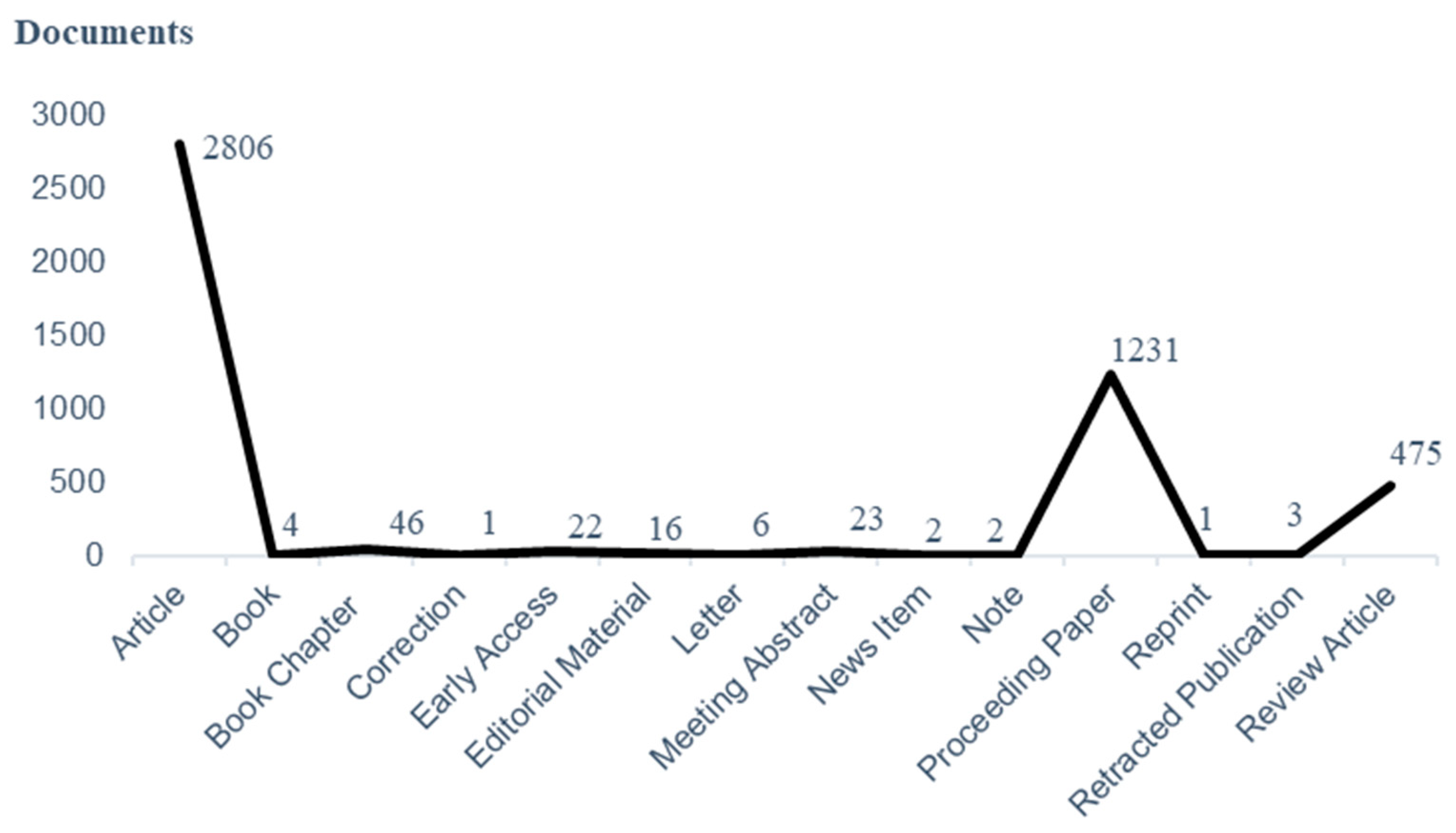

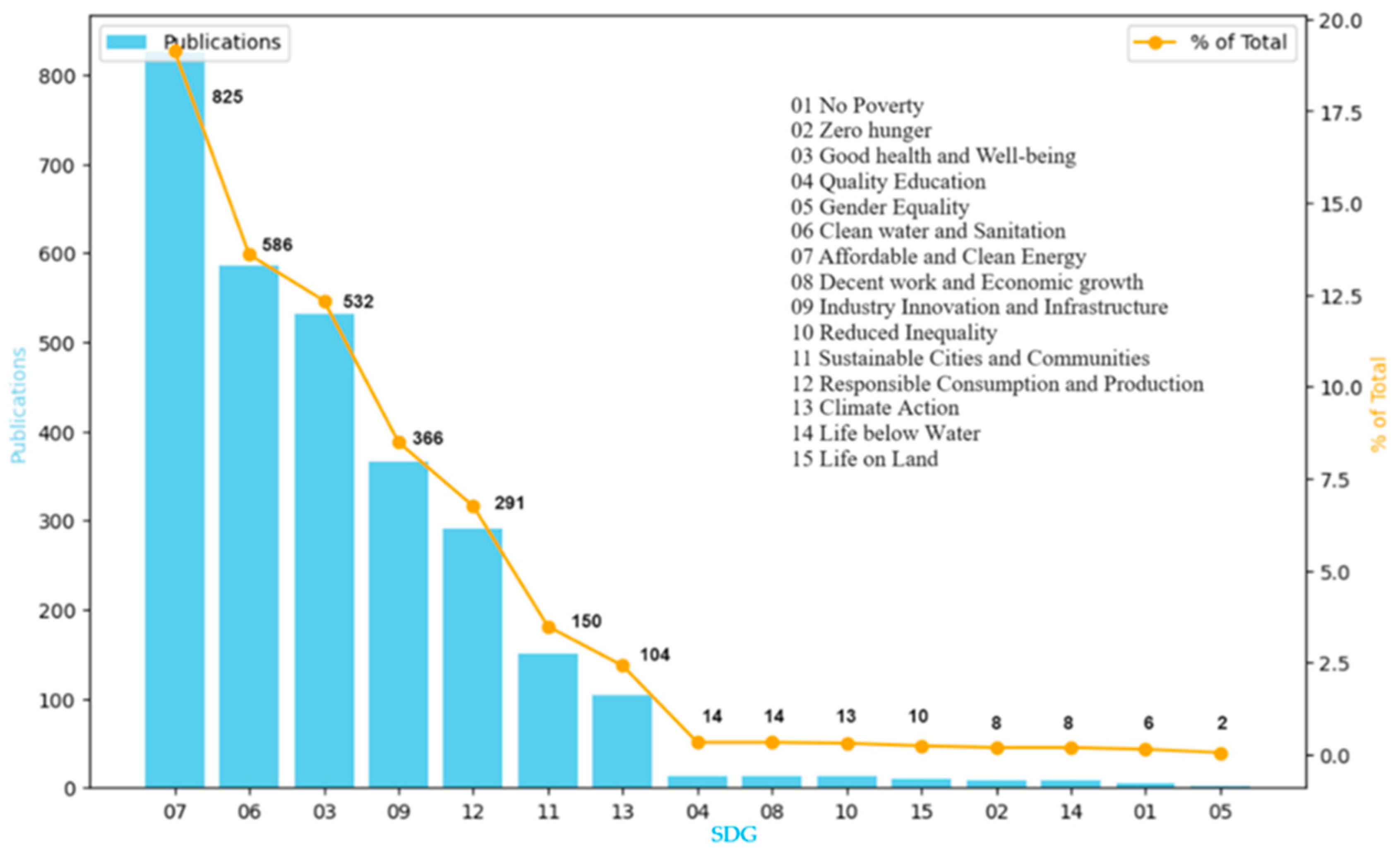
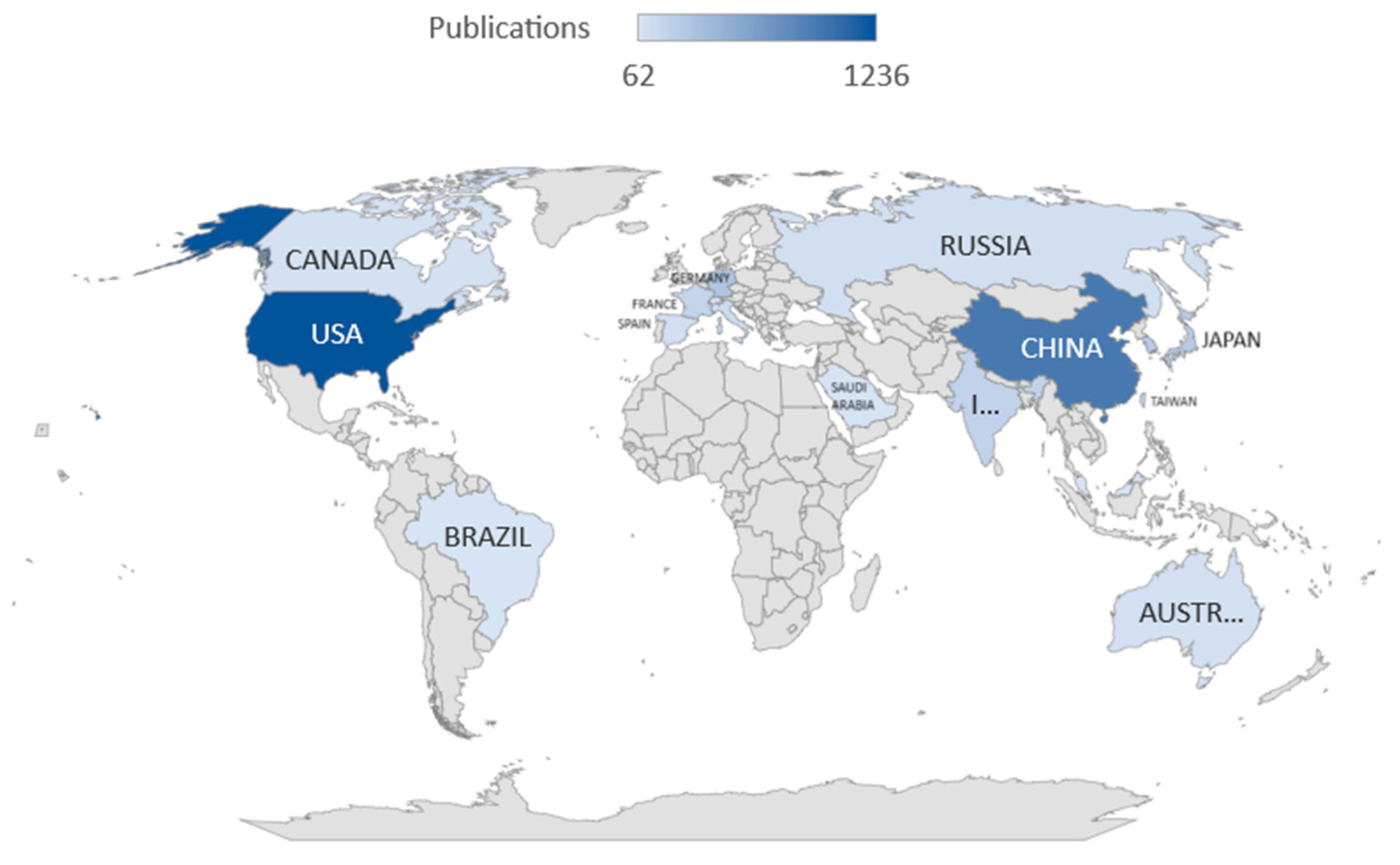
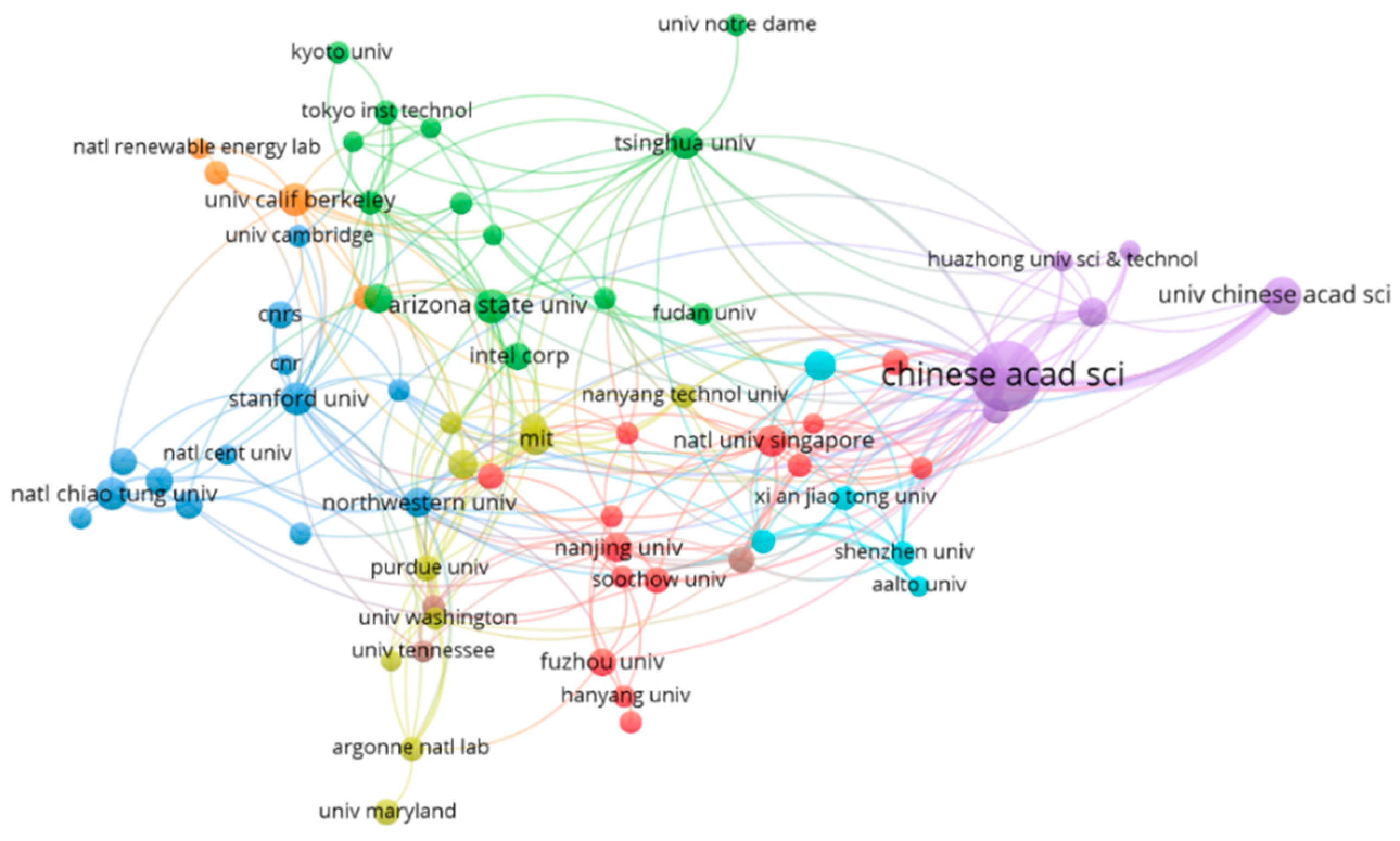
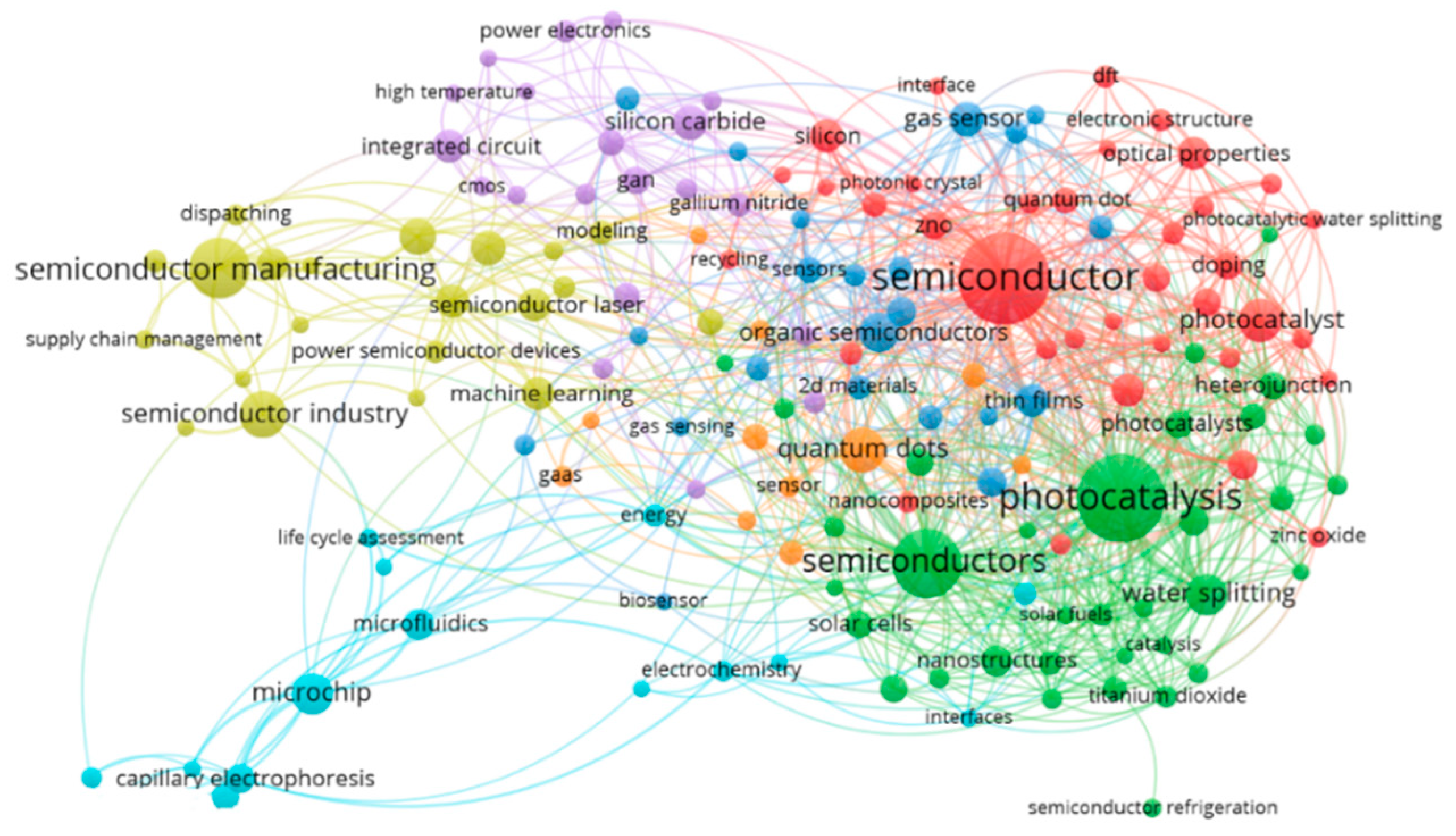
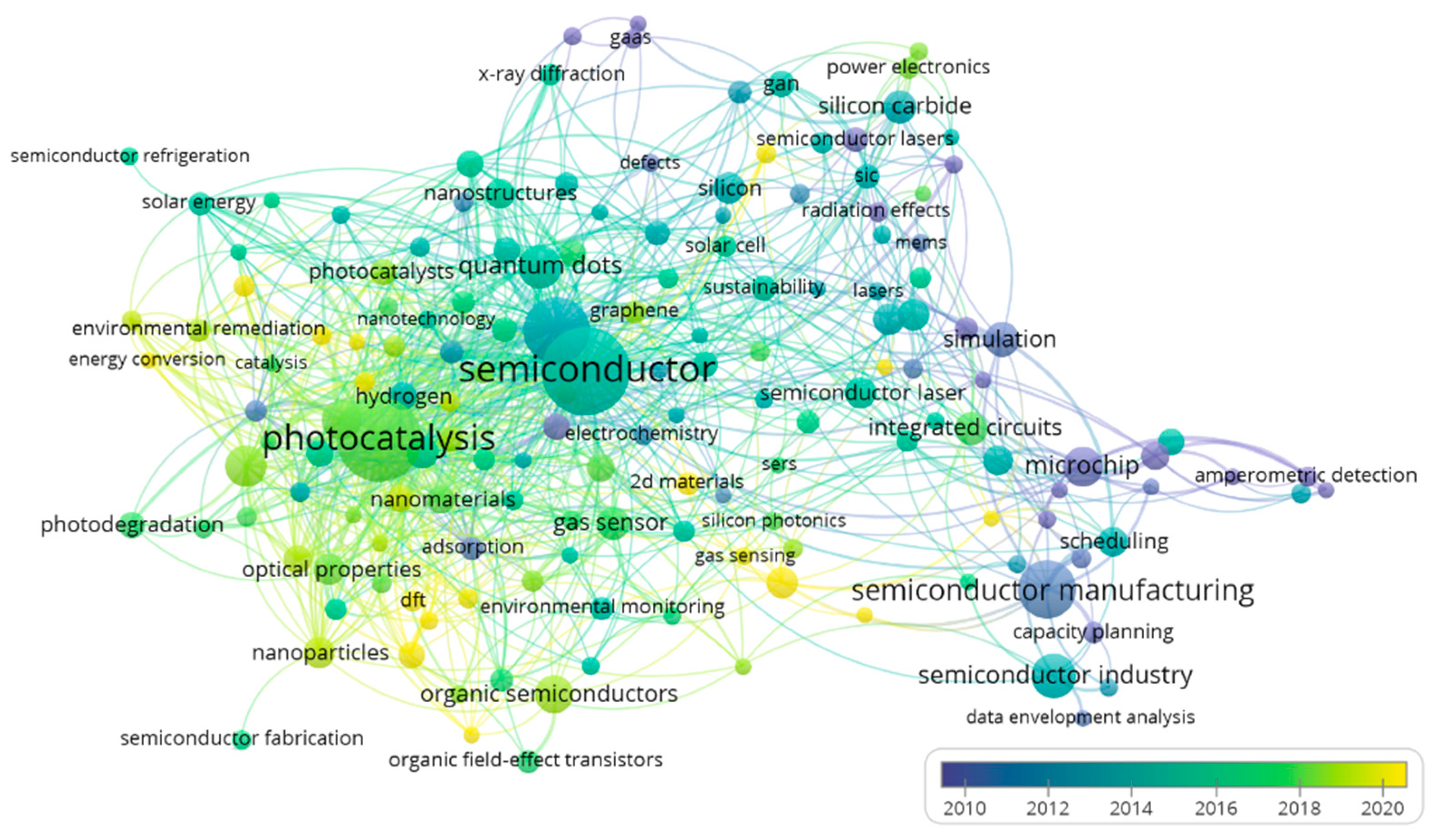
Disclaimer/Publisher’s Note: The statements, opinions and data contained in all publications are solely those of the individual author(s) and contributor(s) and not of MDPI and/or the editor(s). MDPI and/or the editor(s) disclaim responsibility for any injury to people or property resulting from any ideas, methods, instructions or products referred to in the content. |
© 2024 by the authors. Licensee MDPI, Basel, Switzerland. This article is an open access article distributed under the terms and conditions of the Creative Commons Attribution (CC BY) license (https://creativecommons.org/licenses/by/4.0/).
Share and Cite
Liu, Y.-Z.; Lu, W.-M.; Tran, P.P.; Pham, T.A.K. Sustainable Energy and Semiconductors: A Bibliometric Investigation. Sustainability 2024, 16, 6548. https://doi.org/10.3390/su16156548
Liu Y-Z, Lu W-M, Tran PP, Pham TAK. Sustainable Energy and Semiconductors: A Bibliometric Investigation. Sustainability. 2024; 16(15):6548. https://doi.org/10.3390/su16156548
Chicago/Turabian StyleLiu, Ye-Zhi, Wen-Min Lu, Phung Phi Tran, and Thanh Anh Khoa Pham. 2024. "Sustainable Energy and Semiconductors: A Bibliometric Investigation" Sustainability 16, no. 15: 6548. https://doi.org/10.3390/su16156548
APA StyleLiu, Y.-Z., Lu, W.-M., Tran, P. P., & Pham, T. A. K. (2024). Sustainable Energy and Semiconductors: A Bibliometric Investigation. Sustainability, 16(15), 6548. https://doi.org/10.3390/su16156548





